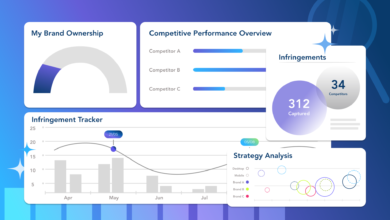Digital Visibility: The Key to Building or Breaking Brand Trust

▼ Summary
– Online brand perception is now primarily shaped by visibility in organic search and generative AI tools.
– AI platforms often amplify uncontrolled content from third-party sources, creating risks of misinformation and negative sentiment.
– Brands must actively monitor and optimize their digital presence across owned channels to influence AI-generated narratives.
– Continuous refinement of brand assets and content is essential to maintain positive visibility and build trust.
– Proactive management of digital visibility directly impacts customer decisions, employee recruitment, and shareholder confidence.
In today’s digital marketplace, how your brand appears online directly shapes public perception and trust. The narratives that surface through organic search results and generative AI platforms now determine whether potential customers view your organization as credible or questionable. What people discover about your company in these digital spaces can either solidify their confidence or destroy it within moments.
Businesses must actively manage both traditional search visibility and emerging AI tools to ensure customers, employees, and stakeholders encounter accurate information. This begins with helping artificial intelligence systems properly comprehend your brand identity and carefully shaping the sources these platforms reference.
The Double-Edged Sword of Digital Presence
Strong online visibility remains crucial for business success. Positive digital exposure builds trust, establishes authority, and enhances legitimacy, all of which translate to financial benefits. Research indicates that 87% of consumers willingly pay premium prices for products from brands they trust.
However, AI technologies have fundamentally altered how audiences interact with information. Brand perception increasingly forms through generative AI summaries rather than through company-controlled websites or blogs. When AI overviews appear in search results, organic click-through rates typically decline by over a third. People now develop opinions about companies within AI interfaces rather than following traditional customer journey paths.
As more consumers turn to artificial intelligence for discovery and research, organizations need deliberate strategies to influence what these systems show millions of users. Without such approaches, uncontrolled sentiment and misinformation can severely damage brand reputation long before anyone visits official company platforms.
Negative visibility rapidly deteriorates trust, which subsequently weakens customer affinity, employee loyalty, and shareholder confidence. In this transformed search environment, brand presence must demonstrate resilience both during normal operations and throughout crisis situations.
Primary Risks to Online Brand Credibility
Unmanaged digital content can quickly harm brand perception across both organic search and AI platforms. Artificial intelligence frequently amplifies material from external sources like Reddit, Wikipedia, and Yelp, spaces where misinformation and negative reviews may circulate without oversight.
Beyond standalone AI platforms, the integration of AI into search results has effectively eliminated the fact-checking phase of user research. Considering that generative AI produces incorrect information more than half the time, this represents a direct threat to brand credibility.
Transforming Digital Visibility into Sustainable Value
With proper insights and strategic planning, companies can optimize their online presence, protect against negative sentiment and misinformation, and secure their narrative for future growth.
Monitor Your Brand Narrative
Begin by analyzing how your brand performs in generative AI summaries and organic search from a storytelling perspective. Evaluate how frequently your brand appears in AI responses, where these mentions occur, the prevailing sentiment, related search queries, and the percentage of AI-cited sources that you control. This assessment reveals clear visibility opportunities.
This process provides comprehensive understanding of your digital footprint:
Where your brand currently appears?
These insights enable more intelligent, effective strategies that strengthen brand trust and connection.
1- Optimize Your Digital Assets
Use these findings to refine your owned assets and digital mentions. The missed opportunities and key risks identified in your online narrative should direct your asset prioritization efforts.
For controlled visibility, maintain consistent brand messaging across every channel and platform you manage, including websites, social media accounts, and executive profiles. This consistency helps both AI and search algorithms better understand and value your brand when generating responses.
While owned assets form the foundation, their credibility influences third-party voices like press coverage and customer reviews. The more you reinforce trustworthiness through controlled content, the more AI systems recognize your brand as reliable. Beyond your primary website, a diverse ecosystem of digital assets demonstrates authenticity, specialized expertise, and credibility.
2- Maintain Continuous Refreshment
Successful visibility strategies remain dynamic rather than static. To keep digital presence working advantageously, organizations must consistently monitor, integrate, and re-optimize their digital landscape and assets.
This approach keeps content current and aligned, enabling identification of emerging risks and opportunities. Ongoing improvement and asset development strengthen brand presence, perception, and long-term value.
3- Take Ownership of Brand Perception
Your brand’s story will be told regardless of your participation. Every search result, AI summary, and digital mention either builds trust or gradually undermines it. This represents the new business reality.
As brand leaders, you face a critical choice: actively guide and strengthen how your organization appears online, or leave the narrative to chance, potentially sacrificing trust, credibility, and the long-term relationships that drive business success.
This extends beyond algorithms and search rankings. It influences how customers select vendors, how employees choose workplaces, and how shareholders determine investment opportunities. The digital front door now creates both initial and lasting impressions. Once trust erodes, restoration becomes exceptionally difficult.
Don’t allow third-party platforms or imperfect AI outputs to define your identity. Proactively shape your digital visibility and narrative to protect current trust while building enduring value for everyone who believes in your brand.
(Source: MarTech)





